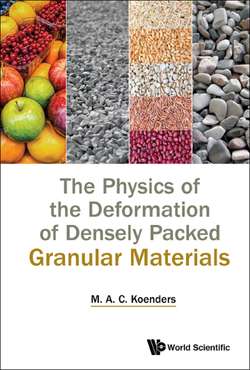Читать книгу The Physics of the Deformation of Densely Packed Granular Materials - M A C Koenders - Страница 14
1.6Contact laws in terms of material parameters
ОглавлениеA question that is particularly of interest to the simulation community concerns the matter whether the spring constant can be related to the material properties of the particles. The prime candidate for such a theory is the Hertzian contact theory, which deals with two elastic bodies that are being compressed together — [Hertz, 1882]. The details are in [Landau and Lifschitz, 1976] and more extensively in the [Johnson, 1985] book on contact mechanics.
For two spheres pressed together by a force F⊥ the distance between the centres of two spheres with radii R and R′ is reduced by an amount D⊥
where the parameter Q contains the elastic constants (Young’s moduli E, E′ and Poisson’s ratios v, v′) of the materials of which the solid bodies are made:
An obvious aspect of this force-indentation formula is that the force-displacement relationship is non-linear. An incremental relationship is easily obtained
A relationship between the proposed spring constant and the material parameters of the particles could then be proposed as some assembly average value of k(F). For simulation purposes that would be very unsatisfactory and the vast majority of simulists code for the original relationship between D⊥ and F⊥. For analytical modelling, however, where interactive properties frequently appear as sums over nearby particles, an averaging approach may be convenient for theoretical purposes.
In two dimensions, relating a spring constant to material properties can be ascertained by looking at the compression of two cylinders along their axes. The Hertzian relationship is, see [Puttock and Thwaite, 1969] and [Williams and Dwyer-Joyce, 2001]
where ℓ is the length of the axes of the cylinders and R, R′ are the cylinder radii. Note that the expression essentially depends on the force per unit length.
This expression is also non-linear, but not easily employed, because inverting it (to give F⊥ as a function of D⊥) leads to extra numerical work.
Figure 1.5. Contact stiffness as a function of the applied compressive force for two spheres and two cylinders. The parameters used are as follows: Q = 10–8 m2 N–1; all radii .01m and the cylinder length ℓ = .01m.
The expression can be differentiated with respect to D⊥ and then ∂F⊥/∂D⊥ as a function of F⊥ may be obtained,
A comparison of the contact stiffnesses for the cases of two spheres and two cylinders is illustrated in Fig. 1.5. It is seen that there is a very substantial variation in the result, especially lightly loaded contacts have a vanishingly small incremental stiffness.
The assumption made here is that the contact areas are immaculately clean and that the contact is perfectly smooth. For two particles made of a natural material — sand particles, for example — that assumption is obviously severely contestable. Further research on two fractal surfaces pressed together is reported in [Hanaor et al., 2015]. As the only purpose of the contact stiffness is to hinder two particles from overlapping (and do so in a controlled manner), it could be argued that any stiffness is fine, as long as the indentation is such that only a very small overlap (compared to the typical radius of the particles) is effected at the typical contact force regime in the assembly. It is also noted that for particles composed of natural materials a number of plastic effects can be expected (including breakage). Therefore, frequently, researchers just take a constant value for the contact stiffness and add friction, for example [Kuhn, 1999]. This is computationally simple and achieves the purpose of rectifying the problems of determining the contact forces in the case that the assembly is not in an isostatic state, at the expense of some physical realism. This is a perfectly reasonable thing to do.
In some sense the details of the normal interaction are not that critical. The tangential stiffness, including frictional effects can be added to the interaction. There are various approaches. A well-known one takes account of slip in an annulus inside the contact area. The extent of the annulus depends on the applied force ratio. A fair amount of ink has been spilt over this problem; quoting [Johnson, 1985]: ‘In a paper of considerable complexity, [Mindlin, 1949], [Mindlin and Deresiewicz, 1953], have investigated the changes in surface traction and compliance between spherical bodies in contact arising from the various possible combinations of incremental change in loads: normal force increasing, tangential force increasing; normal force decreasing, tangential force increasing; normal force increasing, tangential force decreasing; etc.’ The parameters needed are the material stiffness, Poisson’s ratio and a friction coefficient. Despite the complexity of the calculations the result in terms of incremental contact law is not dissimilar from the one obtained from the phenomenological approach as pursued above. All the notes regarding the idealisation of the problem, and therefore the question marks that accompany an application to the ‘dirty’ materials of which the real world is composed, are relevant again. It could also be argued that an analysis meant to explain friction based on the assumption of a friction coefficient is tautological, at best adding details to the mechanism.
